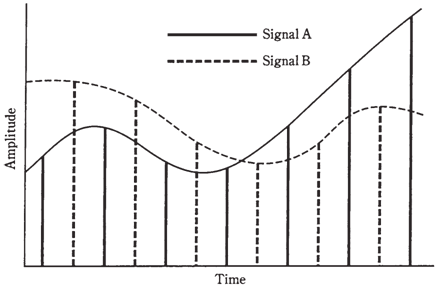Detection of PM signals
The Pulse modulation (PM) operates at a low duty cycle. The pulses are shorter in duration than intervals between them. A PM signal is mainly empty space. The ratio of average signal power to peak signal power is low, often much less than 1 %.Stronger or longer pulses increase effective signal amplitude;weaker or shorter pulses result in reduced amplitude. As of this, PM can be detected similar to AM.
A major advantage of PM is that it is mostly empty space. With pulse amplitude modulation (PAM), pulse code modulation (PCM) or pulse duration modulation (PDM), the time interval is constant between pulse centers. Even at the maximum modulation, the ratio of on time to off time is low. Hence, two or more signals can be intertwined on a single carrier. A PM receiver can pick out one of these signals and detect it, ignoring others. This is called as time-division multiplexing.

Figure--Time-division multiplexing of 2 different signals (A and B) on a single- pulsed carrier.
The time-division-multiplex communications circuit requires that receiver be synchronized with transmitter. This is simple to do if the pulse frequency is constant. The receiver and transmitter is clocked from a single, independent, primary time standard like the broadcasts of radio station WWV. The receiver detector is blocked off during the intervals between transmitter pulses and opens up only during windows lasting as long as longest transmitter pulses.
The received data can be selected by adjusting windows to correspond with the desired pulse train. As the duty cycle of any single signal is so low, it is possible to multiplex dozens or hundreds of signals on a single transmitted carrier.